Buckminster Fuller presents, among the many visionary topics covered in his 1980 master work, what he calls the computer accounting switchover, which is arguably what today we call the Internet of Things and the third industrial revolution. He describes his incredible life journey and mission as a designer for humanity, providing inspiration and courage for those who may strive to be as bold:
Now that I have proven that an individual can be world-effective while eschewing either money or political advantage-making, I do my best to discourage others from taking patents, which almost never “pay off” to the inventor. [...] Ideas are easy to come by; reduction to practice is an arduous but inspirationally rewarding matter.
Indeed, we too made the unconventional decision to publish, not patent,*science page as we arduously advance the realisation of Bucky's prescient vision of technology, economics and humanity.
In researching his 2001 work on the broad subject of software, M. Mitchell Waldrop "had begun to notice how often the name J.C.R. Licklider came up". Indeed, in a career spanning from the Second World War to the end of the Cold War, "Lick" occupied key positions from which his prescient vision would subtly influence generation after generation. Consider the introduction to his 1960 paper Man-Computer Symbiosis where he proclaims:
The hope is that, in not too many years, human brains and computing machines will be coupled together very tightly, and that the resulting partnership will think as no human brain has ever thought and process data in a way not approached by the information-handling machines we know today.
Is more than half a century not too many years? This thoroughly researched history reminds us that neither technology nor vision alone is sufficient to significantly advance humanity. An enduring commitment to both, embodied in patient, persistent individuals provided with an adequate platform and resources, is instead a potent, albeit precarious, formula for profound impact.
Clay Shirky's 2008 work is a prescient examination of the existing and emerging social tools of the day, their potential impact on society, and, critically, the means by which they may bring about revolutionary change. Quelling the impatience of those at the forefront of technological development:
The most profound effects of social tools lag their invention by years, because it isn't until they have a critical mass of adopters, adopters who take these tools for granted, that their real effects begin to appear.
At the time of publication, Twitter and Facebook were but a few years old, while today they've celebrated a decade and been joined by countless other social networks and tools. Shirky argues:
[F]or young people today, our new social tools have passed normal and are heading to ubiquitous, and invisible is coming.
Indeed this is what we observe today. Especially for the younger demographic, a complementary collection of tools, both social and purely technological, have become nearly invisible, such that when cleverly combined, they may bring about profound societal change.
James Gleick's 2012 work opens by describing the 1948 invention of the transistor as: "the second most significant development of that year". Indeed, Claude Shannon's A Mathematical Theory of Communication would establish the bit as a unit of measure of information, "as though there were such a thing, measurable and quantifiable, as information".
Through engaging storytelling, Gleick takes the reader from the history of information, beginning with African drums, to its theory, beginning with Shannon, to its flood:
As the printing press, the telegraph, the typewriter, the telephone, the radio, the computer, and the Internet prospered, each in its turn, people said, as if for the first time, that a new burden had been placed on human communication: new complexity, new detachment and a frightening new excess.
Sensing and understanding the world as information is a powerful framework for grasping the Internet of Things and the third industrial revolution.
Jaron Lanier's 2013 work charts a path towards a humanistic information economy:
The foundational idea of humanistic computing is that provenance is valuable. Information is people in disguise, and people ought to be paid for the value they contribute that can be sent or stored on a digital network.
To achieve this, he argues that "everyone will need to have a unique commercial identity in a universal public market information system", similar to how machines and devices have unique identities. Interestingly, in the years following the book's publication, the proliferation and standardisation of RFID & IoT have already made the unique identification of physical people and things viable at scale. Lanier concludes the afterword suggesting that
in ten or twenty years vast new automatic or highly efficient systems will come into play, and the data to drive those systems will come from masses of people. It's a hypothesis awaiting test.
Indeed, this is a hypothesis on which reelyActive was founded*our history and which continues to be core to the mission and vision of the company. Who Owns the Future? remains arguably the best technologically-inspired reference for a future economy and society that is intrinsically human-centric.
Malcolm McCullough's 2013 work examines the recent development of the ambient as an interface in an age where technologies increasingly vie for one's attention. He argues for architecture and interaction design to emphasise that
the aesthetics of everyday experience depend [...] more on the discovery, navigation, and engagement of local affordances.
Recognising the rise of pervasive computing, RFID and other human-scale technologies as part of our daily context, McCullough suggests embracing these as part of an ambient commons which may "invite tuning in instead of tuning out."
Indeed, our own concept of hyperlocal context can be imagined as foundation for an ambient commons, just as it served for our Log in to Life experiment of the same year, equally intended to promote "a new mindfulness to context."
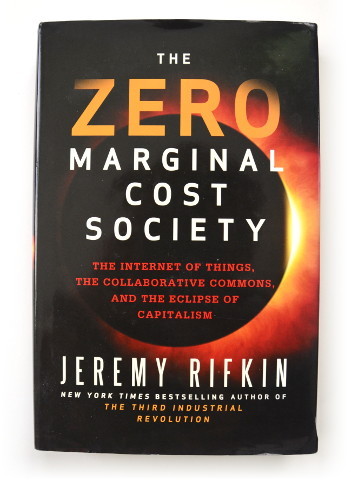
Jeremy Rifkin's 2014 work evokes much of Fuller's optimism for what we today call the Internet of Things:
What makes the IoT a disruptive technology in the way we organize economic life is that it helps humanity reintegrate itself into the complex choreography of the biosphere, and by doing so, dramatically increases productivity without compromising the ecological relationships that govern the planet.
However, Rifkin delves deeper into the evolving economic models, speculating on the nature and timeline of a revolutionary shift:
the two economies will become accustomed to functioning in more of a hybrid partnership, with the Collaborative Commons increasingly becoming dominant by the mid-twenty-first century and the capitalist economy settling into a more supplementary role.
Understanding the economic impact of the IoT and Collaborative Commons facilitates the critical analysis of the evolving business models for the underlying technology platforms.
Frederic Laloux's 2014 work provides a comprehensive introduction to an organisational structure achieved through humanity's shift to a new stage of consciousness:
"fueled not by the power of human will, but by the much greater power of evolution, the engine of life itself".
Where the other authors here focus on the economic models, future of work and human impact of the next industrial revolution, Laloux addresses the organisations likely to not only emerge from, but arguably to drive this revolution themselves.
Every living thing in the ecosystem of life—every cell, every sentient being—senses its environment, enters into harmony with others, and explores new avenues. Solutions are quickly iterated; what doesn't work is quickly discarded, and what works spreads quickly throughout the system.
Interestingly, but perhaps not surprisingly, this seems as fitting a paradigm for the Internet of Things itself, as it does for the organisations working to make it a reality, spearheading the next industrial revolution.
In his wide-reaching 2015 work, Matt Ridley argues that (bottom-up) evolution, rather than (top-down) design, is the force that shapes everything from our culture to our technology.
Ridley highlights just how often 'evolution was taken as a prescription for interference' with regards to how we organise ourselves, our culture, our politics and our technology. Closing with a chapter on the Evolution of the Internet, Ridley points out:
[F]or all its messiness, the internet is not chaotic. It is ordered, complex and patterned. It is a living example, before our eyes, of the phenomenon of evolutionary emergence — of complexity and order spontaneously created in a decentralised fashion without a designer.
This is, of course, also our vision for the emerging Internet of Things. And while the messiness of IoT has already prompted plenty of prescriptive interference, Ridley, in closing, reminds us:
For far too long we have underestimated the power of spontaneous, organic and constructive change driven from below, in our obsession with designing change from above. Embrace the general theory of evolution. Admit that everything evolves.
Avoid interference, embrace emergence, and let the future shape itself.
Andrew Hinton's 2015 work is aptly marketed as Making sense of making sense. Written from the perspective of an information architect and UX strategist, it promotes design-thinking that is empathetic to the individual drowning in Gleick's "flood" of information from the software and interfaces of our modern technological world.
Understanding how we humans make sense of context allows the engineers and designers of the IoT to create human-centric environments which empower rather than overwhelm individuals.*context page
Michael Patrick Lynch's 2016 work aims to "examine the philosophical foundations of [...] our digital form of life". The motivation? The urgent necessity to avoid the fate that concerned Bertrand Russell: being swallowed up by our technology.
The Internet of Things is becoming the Internet of Us, and figuratively, if not yet literally, we are becoming digital humans.
Addressing privacy and the concept of a person, Lynch affirms the importance of respecting our inherent dignity as autonomous individuals. He argues that:
[Privacy] matters, at least in part, because information privacy is linked to autonomy, and thereby an important feature of personhood itself.
Consistent with Rifkin and Gleick , who are cited throughout, Lynch argues that we should not fear information technology itself, but rather be mindful of our uses of the technology: the "us" in Internet of Us. It is "us" who collectively create the future, and Lynch places the responsibility on "us" to understand so that we can indeed be mindful.
Arun Sundarararjan's 2016 treatise introduces the term "crowd-based capitalism" to represent the emerging organisation of economic activity, whose sustained evolution rests upon:
- The consumerization of the digital
- The digitization of the physical ("rendering of things as information")
- The emergence of decentralized peer-to-peer
- The digitization of trust
Technology platforms figure prominently in the optimistic outcome scenarios of economics and employment, similar to those discussed by Fuller and Rifkin. Concluding with a citation by Nobel Laureat Michael Spence:
The truth is that the Internet-led process of exploiting under-utilized resources - be they physical and financial capital or human capital and talent - is both unstoppable and accelerating.
Sundarararajan's extremely well researched work provides firm foundations, but, as should be expected, no formula for the future.
History suggests that it is neither possible nor economically viable to simply adopt existing rules and apply them to a new economy. The challenge, then, is to determine what comes next.
One may again conclude that it is "us" who collectively create that future.
Klaus Schwab's 2016 work argues that a fourth and distinct industrial revolution is under way, and, from an economist's perspective, he emphasizes the ways in which technology and society coexist. For instance, the relentless advancement of technology, unchecked, threatens to compromising our traditional sources of meaning and our collective sense of purpose...
[or] we can use the fourth industrial revolution to lift humanity into a new collective and moral consciousness based on a shared sense of destiny.
Indeed, Schwab's writing is replete with subtle optimism, like Rifkin , which is refreshing given the challenge ahead, overcoming entrenched business and political interests.
With effective multistakeholder cooperation, I am convinced that the fourth industrial revolution has the potential to address—and possibly solve—the major challenges that the world currently faces.
Technology will inevitably change the future, but, as Schwab reminds us, it is only through cooperation that we guide and shape the legacy of such change.
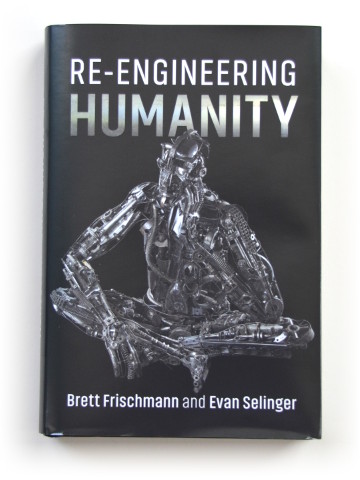
In their timely and thorough 2018 treatise, Brett Frischmann and Evan Selinger:
defend the idea that one of the most important constitutional questions of the twenty-first century is how to sustain the freedom to be off, to be free from techno-social engineering, to live and develop within underdetermined techno-social environments.
In an era where the Internet of Things threatens to spread the mechanical "click-and-accept" paradigm of software and online services into every aspect of our daily lives, as developers of the underlying technologies, we have not only an opportunity, but rather a duty, to enshrine this freedom in our products and platforms.
With a view to "elevate core human capabilities above satisfying engineered preferences and beliefs" the authors' practical proposals include semantic discontinuities (room to play), end-to-end design (engineered degrees of freedom), and speed bumps (demonstrable deliberation).
Where Lynch and others raise the flag and place the onus on "us", Frischmann and Selinger advance one step further to provide prescriptive foundations for organisations to design and engineer for humanity.
Shoshana Zuboff's 2019 tome examines the origins and nature of surveillance capitalism, best understood as "the privatization of the division of learning in society" which, she argues, is the "the critical axis of social order in the twenty-first century".
Where Lanier argued for a humanistic information economy, Zuboff documents how corporations such as Google and Facebook have in fact appropriated online behavioural surplus for themselves to sell predictions of their users' behaviour at scale. The real-world frontier is consequently the IoT on which the human future for which she argues very much hangs in the balance.
I want to underscore that although it may be possible to imagine something like the "internet of things" without surveillance capitalism, it is impossible to imagine surveillance capitalism without something like the "internet of things".
Unlike Frischmann and Selinger who prescribed practices for organisations to engineer for humanity, Zuboff instead proposes "the strengthening of democratic institutions and the creative construction of a double movement for our time" as the path toward a human future in a third modernity.
The first step down this road begins with naming, establishing our bearings, reawakening our astonishment, and sharing a sense of righteous indignity.
Nadia Asparouhova (previously Nadia Eghbal)'s 2020 work is motivated by the observation that:
over the last twenty years, open source inexplicably skewed from a collaborative to a solo endeavor. And while more people use open source code than ever before, its developers failed to capture the economic value they created: a paradox that makes them just as interesting to reexamine today.
Part 1 details why our adoption of GitHub, JavaScript and the MIT License is typical for centralized communities, which are distinct from the many-to-many online communities to which we've become accustomed. Part 2 argues that open source is consumed like a commodity (with zero marginal cost ) but rather is produced like a commons where the limited resource is the attention of the (often sole) maintainer: in our case jeffyactive.
This echoes the evolution of our business model: our code is free to consume whereas we sell, i.e. limit, access to our "attention" via paid subscriptions. While this is unconventional in the software industry, like Asparouhova we're confident that ours is a model that is not only right, but equally viable:
We're moving toward a future where rewards are heavily influenced by the quality of one's audience more than its size. This affords creators an enormous degree of freedom and helps perpetuate the renaissance of ideas that is already well underway.
